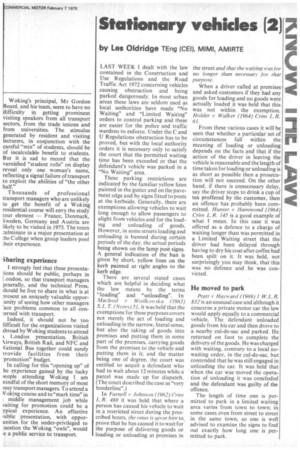Stationary vehicles (2)
Page 77

If you've noticed an error in this article please click here to report it so we can fix it.
by Les Oldridge TEng (CEO, MIMI, AMIRTE LAST WEEK I dealt with the law contained in the Construction and Use Regulations and the Road Traffic Act 1972 concerning vehicles causing obstruction and being parked dangerously. In most urban areas these laws are seldom used as local authorities have made "No Waiting" and "Limited Waiting" orders to control parking and these are easier for the police and traffic wardens to enforce. Under the C and U Regulations obstruction has to be proved, but with the local authority orders it is necessary only to satisfy the court that the permitted waiting time has been exceeded or that the defendant's vehicle was parked in a "No Waiting" area.
These parking restrictions are indicated by the familiar yellow lines painted in the gutter and on the pavement edge and by signs fitted to posts at the kerbside. Generally, there are exemptions allowing vehicles to wait long enough to allow passengers to alight from vehicles and for the loading and unloading of goods. However, in some streets loading and unloading is banned during certain periods of the day. the actual periods being shown on the lamp post signs. A general indication of the ban is given by short, yellow lines on the kerb painted at right angles to the kerb edge.
There are several stated cases which are helpful in. deciding what the law means by the terms "loading" and "unloading". In Macleod i, Woilkowska (1963) S. L. T. (Notes) 51. it was held that the exemptions for these purposes covers not merely the act of loading and unloading in the narrow, literal sense, but also the taking of goods into premises and putting them in some part of the premises, carrying goods from the premises to the vehicle and putting them in it; and the matter being one of degree, the court was entitled to acquit a defendant who had to wait about 12 minutes while a parcel was made up for dispatch. (The court described the case as "very b orderline". ) In Furnell %, Johnson (1962) Crim L. R. 488 it was held that where a person has caused his vehicle to wait in a restricted street during the prescribed hours, the onus is upon him to prove that he has caused it to wait for the purpose of delivering goods or loading or unloading at premises in the street and that the waiting was for no longer than necessarY for that purpose.
When a driver called at premises and asked customers if they had any goods for loading and no goods were actually loaded it was held that this was not within the exemption Holder v Walker (1964) Crim L R 61.
From these various cases it will be seen that whether a particular set of circumstances fall within the meaning of loading or unloading depends on the facts and that if the action of the driver in leaving the vehicle is reasonable and the length of time taken for loading or unloading is as short as possible then a prosecution will not succeed. On the other hand, if there is unnecessary delay, say the driver stops to drink a cup of tea proffered by the customer, then an offence has probably been committed. Hunter v Hammond (1964) Crim L. R. 145 is a good example of what I mean. In this case it was offered as a defence to a charge of waiting longer than was permitted in a Limited Waiting street that the driver had been delayed through having to dry his coat after coffee had been spilt. on it. It was held, not surprisingly you may think, that this was no defence and he was convicted.
He moved to park
Pratt 1, Hayward (1969) 1 W. L. R. 832 is an unusual case and although it concerns a private motor car the law would apply equally to a commercial vehicle. The defendant unloaded goods from his car and then drove to a nearby cul-de-sac and parked. He returned on foot to complete the delivery of the goods. He was charged with waiting, contrary to a local nowaiting order, in the cul-de-sac, but contended that he was still engaged in unloading the car. It was held that when the car was moved the operation of unloading it was concluded and the defendant was guilty of the offence.
The length of time one is permitted to park in a limited waiting area varies from town to town; in, some cases even from street to street in the same town, so one is well advised to examine the signs to find out exactly how long one is permitted to park.












































































































































